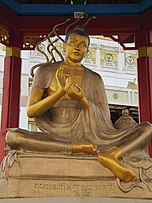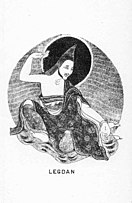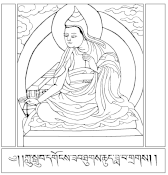มัธยมกะ
บทความนี้ไม่มีการอ้างอิงจากแหล่งที่มาใด |
นิกายมัธยมกะ (สันสกฤต: मध्यमक, Madhyamaka; "สายกลาง"; จีน: 中觀見; พินอิน: Zhōngguān Jìan; ทิเบต: དབུ་མ་པ ; dbu ma pa) เป็นนิกายในศาสนาพุทธฝ่ายมหายานยุคแรกที่ก่อตั้งโดยท่านนาคารชุนะ คำว่ามัธยมกะมาจากคำว่ามัชฌิมาปฏิปทา บางครั้งเรียกนิกายนี้ว่าศูนยตา เพราะคำสอนของนิกายนี้เน้นที่ความว่างเปล่าของสรรพสิ่ง และเรียกผู้ที่นับถือนิกายนี้เรียกว่า มาธยมิกะ (Mādhyamika) คณาจารย์สำคัญของนิกายนี้ เช่น จันทรกีรติ
คัมภีร์
แก้คัมภีร์ที่สำคัญของนิกายนี้มีหลายเล่ม ที่เขียนโดยท่านนาคารชุนะได้แก่ มาธยมิกศาสตร์ ทวาทศนิกายศาสตร์ ปรัชญาปารมิตาศาสตร์ และที่เขียนโดยลูกศิษย์ของท่าน เช่น ศตศาสตร์ของท่านเทวะ กรกาลรัตนศาสตร์ของท่านภาววิเวก
หลักธรรม
แก้คำสอนของนิกายนี้เน้นที่หลักปฏิจสมุปบาทและศูนยตา โดยถือว่าสรรพสิ่งทั้งหลายไม่มีความอยู่ด้วยตัวเอง (สวภาวะ) แต่เกิดได้เพราะอาศัยเหตุปัจจัยอิงกันเกิด ปฏิเสธทั้งทิฐิข้างที่กล่าวอ้างว่าสรรพสิ่งมีอยู่จริง (สัสสตทิฐิ) และที่ถือว่าขาดศูนย์ (อุจเฉททิฐิ) คำสอนของนิกายนี้ขัดแย้งกับนิกายโยคาจารอย่างรุนแรง ในแง่ที่ว่านิกายโยคาจารยอมรับการมีอยู่ของสวภาวะแต่นิกายมัธยมกะไม่ยอมรับ มีการโจมตีกันว่าเป็นมิจฉาทิฐิในพุทธศาสนาทั้งสองฝ่าย
การปฏิเสธคำสอน
แก้นิกายมัธยมกะ เป็นคำสอนแนวปฏิเสธ และเป็นเพียงปรัชญา ที่ทำให้หลุดพ้นไปไม่ได้เป็นเพียงทฤษฎีตามนิกายอื่น ๆ ที่โจมตี[ต้องการอ้างอิง] โดยนิกายที่ต่อยอดให้มัธยมกะ คือนิกายเทนได ที่พยายามต่อความคิด
นิกายมาธยมิกในประเทศต่าง ๆ
แก้- ในประเทศญี่ปุ่นเรียกว่า นิกายซานรอน ได้รับผ่านทางประเทศเกาหลีเมื่อราว พ.ศ. 1168
อ้างอิง
แก้- ทวีวัฒน์ ปุณฑริกวิวัฒน์. ศาสนาและปรัชญาในจีน ทิเบต ญี่ปุ่น. กทม.สุขภาพใจ. 2545
- ประยงค์ แสนบุราณ. พระพุทธศาสนามหายาน. กทม.โอเดียนสโตร์. 2548
ข้อมูล
แก้- Arena, Leonardo Vittorio (2012), Nonsense as the Meaning, ebook
- Arnold, Dan (2010). Nāgārjuna's 'Middle Way': A Non-Eliminative Understanding of Selflessness. In:Revue Internationale de Philosophie vol. 64, no.253: 367-395
- Bhattacharya, Vidhushekhara (1943), Gauḍapādakārikā, Delhi: Motilal Banarsidass
- Brunnholzl, Karl (2004), Center of the Sunlit Sky: Madhyamaka in the Kagyu Tradition, Snow Lion Publications
- Brunnholzl, Karl (2009). Luminous Heart: The Third Karmapa on Consciousness, Wisdom, and Buddha Nature. Shambhala Publications. ISBN 9781559399142.
- Cabezón, José Ignacio; Dargyay, Lobsang (2013). Freedom from Extremes: Gorampa's "Distinguishing the Views" and the Polemics of Emptiness. Simon and Schuster. ISBN 9780861718573.
- Cheng, Hsueh-Li (1981), "The Roots of Zen Buddhism", Journal of Chinese Philosophy, 8 (4): 451–478, doi:10.1111/j.1540-6253.1981.tb00267.x
- Comans, Michael (2000), The Method of Early Advaita Vedānta: A Study of Gauḍapāda, Śaṅkara, Sureśvara, and Padmapāda, Delhi: Motilal Banarsidass
- Cornu, Philippe (2001), "Nawoord", Schijn en werkelijkheid. De twee waarheden in de vier boeddhistische leerstelsels, KunchabPublicaties
- Cowherds (2010). Moonshadows: Conventional Truth in Buddhist Philosophy. Oxford University Press. ISBN 9780199826506.
- Daye, Douglas D. (1971), Major Schools of the Mahayana: Madhyamaka. In:Charles S. Prebisch, Buddhism, A Modern Perspective. Pages 76-96., ISBN 978-0-271-01195-0
- Fuller, Paul (2005), The Notion of Diṭṭhi in Theravāda Buddhism: The Point of View (PDF), Routledge, คลังข้อมูลเก่าเก็บจากแหล่งเดิม (PDF)เมื่อ 2014-12-02
- Garfield, Jay L. (1994), "Dependent Arising and the Emptiness of Emptiness: Why Did Nāgārjuna Start with Causation?", Philosophy East & West, 44 (2), doi:10.2307/1399593, JSTOR 1399593
- Garfield, Jay L. (1995), The Fundamental Wisdom of the Middle Way, Oxford: Oxford University Press
- Garfield, Jay L. (2012), Madhyamaka is Not Nihilism (PDF), Smith College, University of Melbourne
- Garfield, Jay L.; Westerhoff, Jan (2015). Madhyamaka and Yogacara: Allies Or Rivals?. Oxford University Press. ISBN 9780190231293.
- Gomez, Luis O. (1976), "Proto-Mādhyamika in the Pāli canon", Philosophy East and West, 26 (2): 137–165, doi:10.2307/1398186, JSTOR 1398186, คลังข้อมูลเก่าเก็บจากแหล่งเดิมเมื่อ 2016-03-03, สืบค้นเมื่อ 2015-12-06
- Harvey, Peter (1995), An introduction to Buddhism. Teachings, history and practices, Cambridge University Press
- Hayes, Richard P. (1994), Nagarjuna's appeal. In: Journal of Indian Philosophy 22: 299-378
- Hayes, Richard P. (2003), Nagarjuna: Master of Paradox, Mystic or Perpetrator of Fallacies? (PDF)
- Hookham, S.K. (1991), The Buddha within : Tathagatagarbha doctrine according to the Shentong interpretation of the Ratnagotravibhaga, Albany, NY: State University of New York Press, ISBN 978-0791403587
- Hopkins, Jeffrey; Napper, Elizabeth (1996), Meditation on Emptiness
- Kalupahana, David J. (1992), The Principles of Buddhist Psychology, Delhi: ri Satguru Publications
- Kalupahana, David J. (1994), A History of Buddhist philosophy, Delhi: Motilal Banarsidass Publishers Private Limited
- Loy, David (2006), Second Buddha : Nagarjuna - Buddhism's Greatest Philosopher. In: Winter 2006 edition of Tricycle : The Buddhist Review
- Magee, William (1999), The Nature of Things. Emptiness and Essence in the Geluk World, Ithaca, New York: Snow Lion
- Napper, Elizabeth (1989), Dependent-Arising and Emptiness, ISBN 0-86171-057-6
- Newland, Guy (2009). Introduction to Emptiness: As Taught in Tsong-kha-pa's Great Treatise on the Stages of the Path. Snow Lion. ISBN 9781559393324.
- Ng, Yu-kwan (1990), Chih-i and Madhyamika, Hamilton, Ontario: dissertation, McMaster University, p. 1, คลังข้อมูลเก่าเก็บจากแหล่งเดิมเมื่อ February 3, 2014
- Ozkan, Cuma (2013). A comparative analysis: Buddhist Madhyamaka and Daoist Chongxuan (twofold mystery) in the early Tang (618-720) (MA). University of Iowa. doi:10.17077/etd.o9rxrm2t.
- Renard, Philip (2010), Non-Dualisme. De directe bevrijdingsweg, Cothen: Uitgeverij Juwelenschip
- Rizzi, Cesare (1988), Candrakirti, Delhi: Motilal Banarsidass Publishers Private Limited
- Ruegg, D. Seyfort (1981), The literature of the Madhyamaka school of philosophy in India (A History of Indian literature), Harrassowitz, ISBN 978-3-447-02204-0
- Sarma, Chandradhar (1996), The Advaita Tradition in Indian Philosophy, Delhi: Motilal Banarsidass
- Shantarakshita; Ju Mipham (2005), The Adornment of the Middle Way, Padmakara Translation, ISBN 1-59030-241-9
- Suzuki, Daisetz Teitarō (1999), Studies in the Laṅkāvatāra Sūtra, Delhi: Motilal Banarsidass
- Thich Nhat Hanh (1988), The Heart of Understanding: Commentaries on the Prajnaparamita Heart Sutra
- Travagnin, Stefania (2009). The Madhyamika Dimension of Yin Shun. A restatement of the school of Nagarjuna in 20th century Chinese Buddhism (PDF) (PhD). University of London.
- Tsondru, Mabja (2011). Ornament of Reason: The Great Commentary To Nagarjuna's Root Of The Middle Way. Shambhala Publications. ISBN 9781559397421.
- Tsongkhapa, Lobsang Dragpa; Sparham, Gareth, trans.; in collaboration with Shotaro Iida (1993). Kapstein, Matthew (บ.ก.). Ocean of Eloquence: Tsong kha pa's Commentary on the Yogacara Doctrine of Mind (ภาษาทิเบต และ อังกฤษ) (1་ ed.). Albany, NY: State University of New York. ISBN 0791414795. สืบค้นเมื่อ 18 December 2012.
- Tsong Khapa (2002), The great treatise on the stages of the path to enlightenment: Volume 3, Snow Lion Publications, ISBN 1-55939-166-9
- rJe Tsong Kha Pa; Garfield (tr.), Jay L.; Samten (tr.), Ngawang (2006), Ocean of Reasoning, Oxford: Oxford University Press, ISBN 978-0-19-514733-9
- Vetter, Tilmann (1988), The Ideas and Meditative Practices of Early Buddhism (PDF), BRILL, ISBN 90-04-08959-4
- Walser, Joseph (2005). Nagarjuna in Context: Mahayana Buddhism and Early Indian Culture. Columbia University Press. ISBN 9780231506236.
- Warder, A. K. (2000), Indian Buddhism, Delhi: Motilal Banarsidass Publishers
- Westerhoff, Jan (2009). Nagarjuna's Madhyamaka: A Philosophical Introduction. Oxford University Press. ISBN 9780199705115.
- Williams, Paul (2000). Buddhist Thought: A Complete Introduction to the Indian Tradition. Routledge. ISBN 9780415207003.
- Williams, Paul (2002). Buddhist Thought: A Complete Introduction to the Indian Tradition. Routledge. ISBN 9781134623259.
- Williams, Paul (2009). Mahāyāna Buddhism: The Doctrinal Foundations. Routledge. ISBN 9780415356534.
- Wynne, Alexander (2007), The Origin of Buddhist Meditation, Routledge
อ่านเพิ่ม
แก้- Della Santina, Peter (1986), Madhyamaka Schools in India, New Delhi: Motilal Banarsidass
- Harris, Ian Charles (1991), The Continuity of Madhyamaka and Yogacara in Indian Mahayana Buddhism, New York: E. J.Brill
- His Holiness the Fourteenth Dalai Lama (Tenzin Gyatso) (2009), The Middle Way: Faith Grounded in Reason, Boston: Wisdom Publications
- Huntington, C. W., Jr. (1989). The Emptiness of Emptiness: An Introduction to Early Madhyamika. Honolulu: University of Hawaii Press
- Jones, Richard H. (2014), Nagarjuna: Buddhism's Most Important Philosopher, New York: Jackson Square Books
- Jones, Richard H. (2012), Indian Madhyamaka Buddhist Philosophy After Nagarjuna, 2 vols., New York: Jackson Square Books
- Narain, Harsh. The Mādhyamika mind. Motilal Banarsidass Publishers, 1997.
แหล่งข้อมูลอื่น
แก้- The Mādhyamika or the Śūnyavāda school, Surendranath Dasgupta, 1940
- "Madhyamaka Buddhism". Internet Encyclopedia of Philosophy.
- "Nagarjuna". Internet Encyclopedia of Philosophy.
- Thinking in Buddhism: Nagarjuna's Middle Way
- thezensite: articles on Nagarjuna
- Introduction to the Middle Way A contemporary commentary based on the teachings of Dzongsar Khyentse Rinpoche
- Stanford Encyclopedia of Philosophy: Madhyamaka
- Stanford Encyclopedia of Philosophy: Nagarjuna



